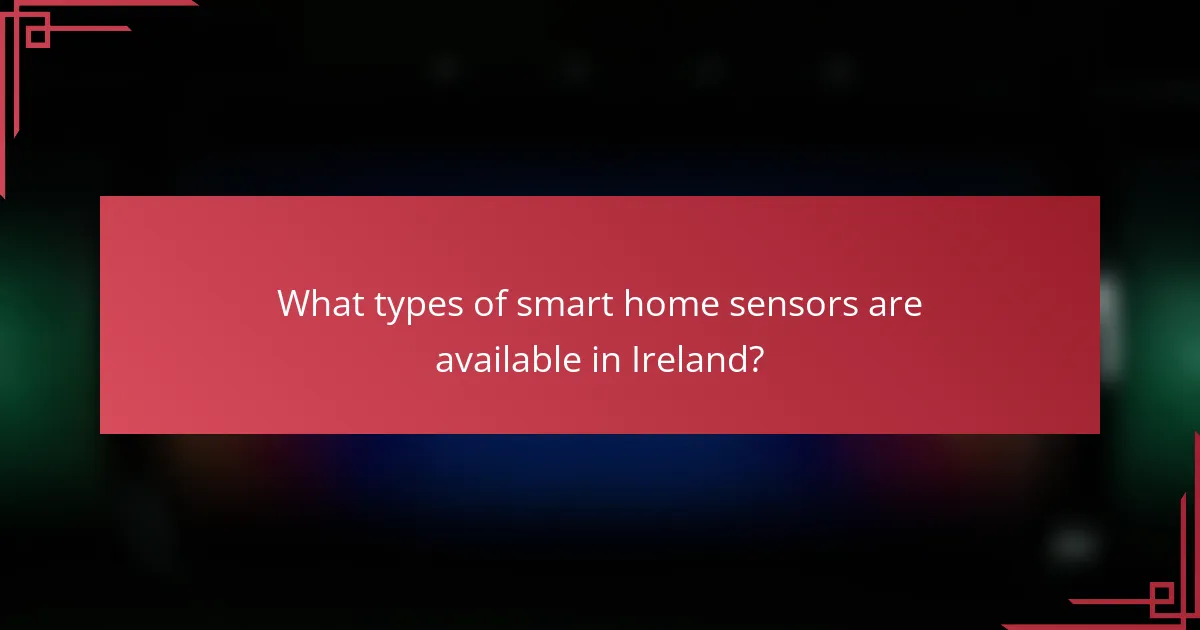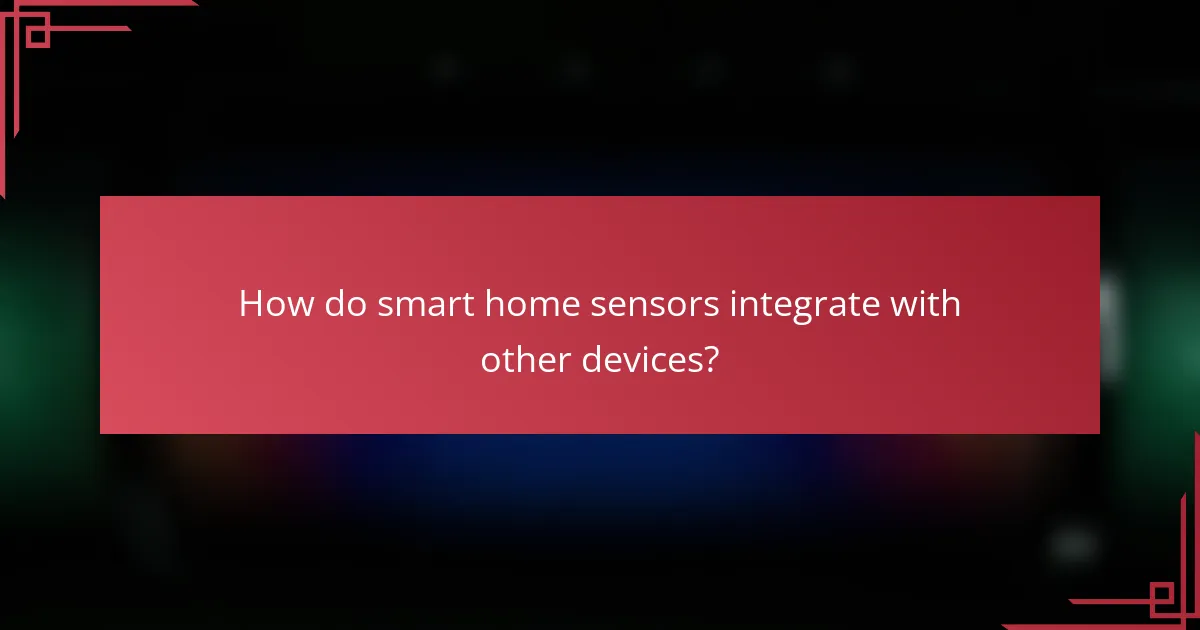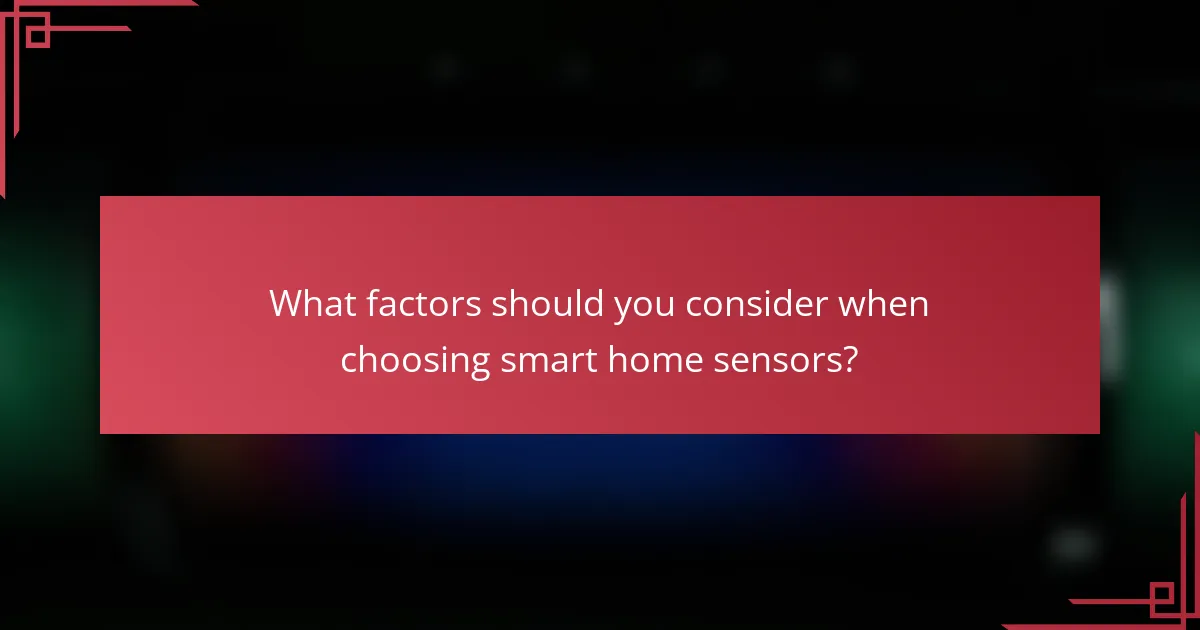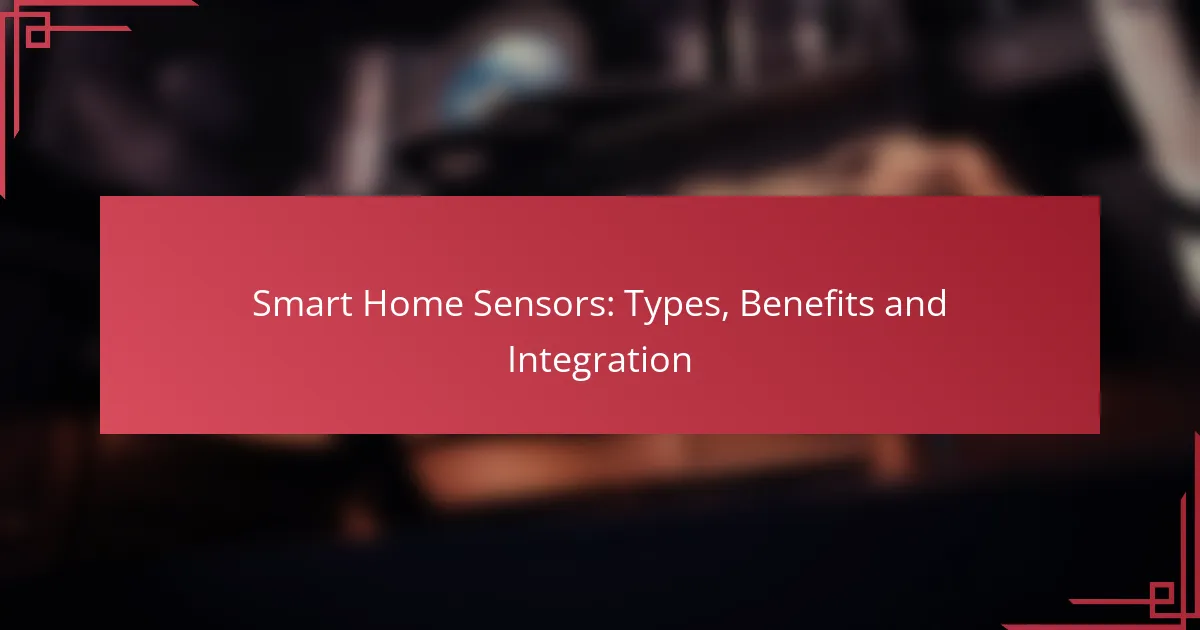Smart home sensors play a crucial role in enhancing security, comfort, and energy efficiency in modern households. With various types such as motion detectors, temperature monitors, and smoke alarms, these devices work together to create a responsive living environment. Their integration with other smart devices allows for seamless automation and real-time monitoring, significantly improving the overall functionality of smart homes.

What types of smart home sensors are available in Ireland?
In Ireland, various types of smart home sensors enhance security, comfort, and energy efficiency. These sensors include motion detectors, temperature monitors, smoke alarms, water leak detectors, and door/window sensors, each serving distinct purposes in a smart home ecosystem.
Motion sensors
Motion sensors detect movement within a designated area, making them essential for security and automation. They can trigger alarms, send notifications, or activate other smart devices when movement is detected.
Common types include passive infrared (PIR) sensors, which sense heat emitted by objects, and microwave sensors, which use radar waves. When installing, consider the sensor’s range and sensitivity to avoid false alarms from pets or passing vehicles.
Temperature sensors
Temperature sensors monitor indoor and outdoor temperatures, allowing for automated heating and cooling adjustments. These sensors help maintain comfort and can contribute to energy savings by optimizing HVAC systems.
Look for sensors that integrate with smart thermostats for seamless operation. Some models also offer humidity sensing, providing a more comprehensive view of indoor climate conditions.
Smoke detectors
Smoke detectors are crucial for safety, alerting homeowners to the presence of smoke or fire. Modern smart smoke detectors can send alerts to smartphones and integrate with other smart home systems for enhanced safety measures.
Choose detectors that meet Irish safety standards and consider models with dual sensors that detect both smoke and carbon monoxide for added protection. Regular testing and battery checks are essential for reliability.
Water leak sensors
Water leak sensors detect moisture and potential leaks, helping to prevent water damage in homes. These sensors can be placed near appliances like washing machines or under sinks to monitor for leaks.
Look for sensors with immediate alerts that can notify you via smartphone when water is detected. Some models can also shut off water supply automatically, providing an extra layer of protection against flooding.
Door/window sensors
Door and window sensors monitor the opening and closing of entry points, enhancing home security. They can trigger alarms or notifications when a door or window is opened unexpectedly.
These sensors are typically easy to install and can be integrated with home security systems. When selecting, consider models with tamper alerts and long battery life to ensure ongoing protection.

What are the benefits of using smart home sensors?
Smart home sensors offer numerous advantages, including enhanced security, improved energy efficiency, increased convenience, and real-time monitoring. These devices work together to create a more responsive and efficient living environment.
Enhanced security
Smart home sensors significantly boost security by providing real-time alerts and monitoring capabilities. Motion detectors, door/window sensors, and cameras can notify homeowners of suspicious activity, allowing for immediate action.
Integrating these sensors with a home security system can create a comprehensive safety net. For example, a door sensor can trigger an alarm if opened unexpectedly, while cameras can send live feeds to your smartphone.
Energy efficiency
Energy-efficient smart home sensors help reduce utility costs by optimizing energy usage. Sensors can detect occupancy and adjust lighting and heating accordingly, ensuring that energy is not wasted in unoccupied rooms.
For instance, smart thermostats can learn your schedule and adjust temperatures automatically, potentially saving homeowners up to 20% on heating and cooling bills. This not only lowers expenses but also contributes to a greener environment.
Convenience and automation
Smart home sensors enhance convenience by automating routine tasks. For example, motion sensors can trigger lights to turn on when you enter a room, eliminating the need to fumble for switches.
Additionally, integrating sensors with smart home hubs allows for customized automation routines. You can set up scenarios where, upon leaving home, all lights turn off, and the thermostat adjusts to energy-saving settings.
Real-time monitoring
Real-time monitoring through smart home sensors provides homeowners with instant updates on various conditions. For example, water leak sensors can alert you to leaks before they cause significant damage, while smoke detectors can notify you of smoke or carbon monoxide presence.
These monitoring capabilities can be accessed via smartphone apps, allowing you to stay informed about your home’s status from anywhere. This proactive approach can prevent costly repairs and enhance overall safety.

How do smart home sensors integrate with other devices?
Smart home sensors integrate with other devices through communication protocols, enabling them to share data and automate tasks. This integration enhances the functionality of smart homes by allowing sensors to work in unison with hubs, mobile applications, and voice assistants.
Compatibility with smart hubs
Smart hubs act as the central point for connecting various smart home devices, including sensors. When choosing sensors, ensure they are compatible with your hub’s communication standards, such as Zigbee, Z-Wave, or Wi-Fi. This compatibility allows for seamless control and automation across devices.
For example, if you have a smart hub that supports Zigbee, select sensors that also use this protocol to ensure they can communicate effectively. This setup can facilitate automation scenarios, such as turning on lights when motion is detected.
Integration with mobile apps
Many smart home sensors come with dedicated mobile applications that allow users to monitor and control their devices remotely. These apps often provide real-time notifications, data analytics, and the ability to customize settings. Check if the app supports your smartphone’s operating system for optimal functionality.
For instance, a temperature sensor may send alerts to your phone if the temperature exceeds a certain threshold, allowing you to take action promptly. Look for apps that offer user-friendly interfaces and robust features to enhance your smart home experience.
Voice assistant compatibility
Smart home sensors can often integrate with popular voice assistants like Amazon Alexa, Google Assistant, or Apple Siri. This compatibility allows users to control sensors using voice commands, adding convenience to daily routines. Verify that your sensors support the voice assistant you use for smooth integration.
For example, you can ask your voice assistant to check the status of a motion sensor or adjust the settings of a smart thermostat. Ensure that the sensors you choose can be easily linked to your voice assistant for a cohesive smart home ecosystem.

What factors should you consider when choosing smart home sensors?
When choosing smart home sensors, consider factors like sensor range, installation requirements, and brand reputation. These elements significantly impact the effectiveness and reliability of your smart home system.
Sensor range and coverage
Sensor range and coverage are crucial for ensuring that your smart home sensors can effectively monitor the desired areas. Most sensors have a range that can vary from a few meters to over 30 meters, depending on the type and technology used.
For optimal coverage, assess the layout of your home and identify any obstacles that may interfere with signal strength. In larger homes, you may need multiple sensors or a hub to cover all areas adequately.
Installation requirements
Installation requirements can vary significantly between different smart home sensors. Some sensors are designed for easy DIY installation, while others may require professional setup, especially if they need to be integrated into existing wiring or systems.
Before purchasing, check if the sensor requires any specific tools or additional equipment. For instance, battery-operated sensors are typically easier to install than wired ones, which may involve more complex procedures.
Brand reputation
Brand reputation plays a vital role in the reliability and performance of smart home sensors. Established brands often provide better customer support, warranty options, and regular software updates, enhancing the longevity of your devices.
Research customer reviews and ratings to gauge the experiences of other users. Opt for brands that are known for their quality and have a track record of producing reliable smart home products.



